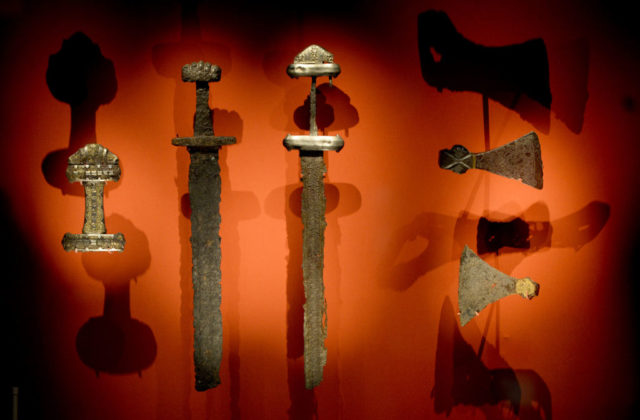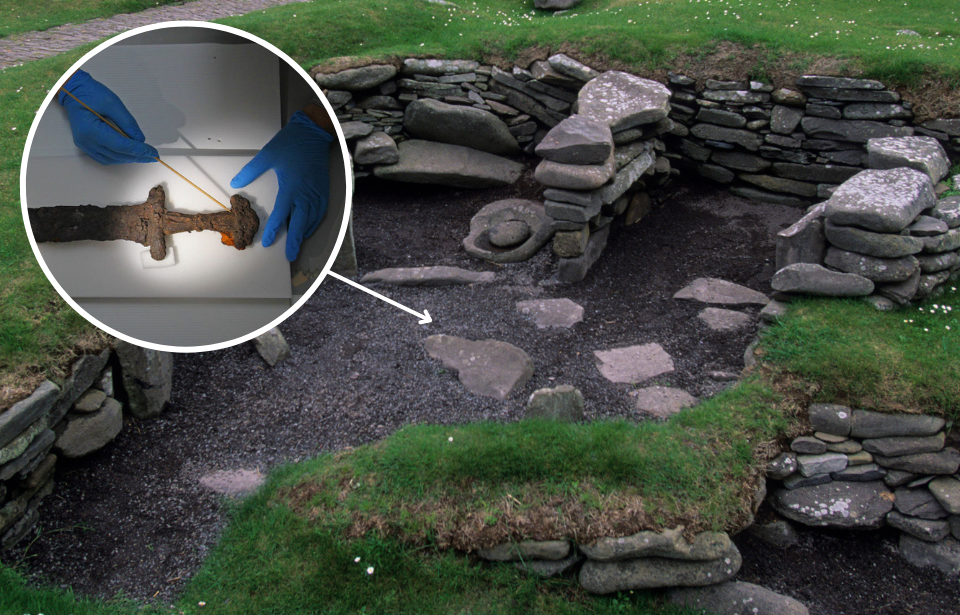A unique discovery is shedding new light on Viking history in the British Isles with breakthroughs that could rewrite the history books as we know it. Two friends in Stavanger, Norway were hoping to find lost treasure, but what they found was far more valuable.
The Gausel Queen
The two friends went out with metal detectors in Jåttå, an area in western Norway where the renowned “Gausel Queen” was found in 1883. This refers to a gravesite of a wealthy Viking woman buried with a variety of treasures from Norway and Ireland. The site is one of the richest graves of a Viking woman ever found, containing silver arm rings, pieces of silver and bronze, pearls, knives, and even parts of a reliquary that was likely taken from somewhere in the British Isles.
The grave of the Gausel Queen, c. 850 AD, buried with horse’s head with harness and beautiful Irish and Norwegian objects. The grave is one of the richest Viking Age woman’s grave findings in Norway. (Ilustration: arkikon.no) pic.twitter.com/mvN1uda29T
— ThorNews (@thornews) December 6, 2017
The Gausel Queen’s connection to Ireland is especially meaningful, as the Vikings were known to raid throughout the area and were also the ones to found the city of Dublin. Viking settlers arrived in 841 CE, creating a hub of trade and expansion into the rest of Western Europe. The Vikings were expelled from the area in 902, but returned in 917 and developed what is now Dublin. The settlement became incredibly successful as a center for wealth and innovation, evident in the shipbuilding and hand-crafted metal artifacts found throughout the city in archeological digs.
The discovery was a ‘truly unique’ find
The friends found pieces of a hilt of a Viking sword and turned them over to the government, which is required by law. Although the sword’s blade is missing, the hilt pieces provide groundbreaking information for archeologists. Containing silver and gold elements carved into intricate animal styles, the sword is typical of other styles found in the Iron and Viking age between 550 and 1050 CE. The three parts found include the main body of the hilt and two side pieces that would have extended outward to make a T-shape.
Nytt funn! Vi har akkurat åpnet en ny utstilling om rikssamlingsjubileet, hva er oddsen for at to uavhengige funn fra vikingtiden passer sammen? Mer: https://t.co/bUWegiV0mB pic.twitter.com/g5dooHF1DK
— Arkeologisk museum (@ArkmuseumUiS) June 2, 2022
“The technique is of a very high quality, and both the lavish and complicated decor and the special formation of the cross guard makes this a truly unique find,” said Zanette Glørstad, an archeologist from the Museum of Archaeology at the University of Stavanger. The style of the sword also suggests it was likely imported from elsewhere in Europe. Of the 300 or so Viking swords found in Norway, the Stavanger sword resembles only 20 of those.
Experts believe that the intricate details of the sword were forged in England or France around 800 CE. These impressive finds are changing the way historians understand the Jåttå/Gausel area, which was previously believed to be an area where Viking alliances formed and looting was common. “The location of the find close to the Gausel Queen means that we have to take a new look at the entire Jåttå/Gausel area,” explained Stavanger researcher Håkon Reiersen. The sword and the Gausel Queen burial site could mean that Gausel was actually a significant hub for trade and communication across the North Sea.
The secrets of the sword
The sword is made up of silver and gold and contains unique metalworking techniques like “niello” – a black metallic alloy used to add a darker definition to the silver designs. In a press release from the Museum of Archeology at the University of Stavanger, Glørstad gave more information about the provenance of the sword: “The sword is probably what we call a D-sword, i.e. one of the most richly ornamented and heaviest sword types from the Viking Age… The lower hilt is decorated in the same way as the grip, and at each end the hilt is designed as an animal head. The closest parallel we know of is a sword from the island of Eigg in Scotland, which was found in a grave from the 8th century.”

The sword is undergoing restoration at the Museum of Archaeology at the University of Stavanger, where researchers are carefully peeling away layers of dirt and debris obscuring the ornate animal designs. Conservator Cora Oschmann shared her thoughts on working on such an important artifact: “It is very exciting to work on a find like this. It is challenging work, but we uncover new details daily.”
More from us: 3500-Year-Old Mummy of King Amenhotep I Has Been Digitally Unwrapped
While the sword continues to undergo conservation, who knows what other secrets will be uncovered? Since the two metal detectorists only discovered three pieces of the ancient weapon, more parts – including the blade – could be unearthed in the future.
